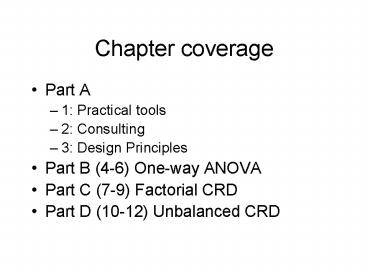Chapter coverage - PowerPoint PPT Presentation
1 / 18
Title:
Chapter coverage
Description:
Part B (4-6) One-way ANOVA. Part C (7-9) Factorial ... Convenience. Restricted Randomization. Clustering ... One at a time (OAT) designs. Multifactor designs ... – PowerPoint PPT presentation
Number of Views:115
Avg rating:3.0/5.0
Title: Chapter coverage
1
Chapter coverage
- Part A
- 1 Practical tools
- 2 Consulting
- 3 Design Principles
- Part B (4-6) One-way ANOVA
- Part C (7-9) Factorial CRD
- Part D (10-12) Unbalanced CRD
2
Chapter coverage
- Part E (13-15) Questioning Assumptions
- Part F (16-18) ANCOVA
- Part G (19-21) Random and Mixed Effects
- Part H Nested and Split Plot Designs
- Part I Repeated Measures and Cross-over Designs
3
Important Design Principles
- Replication
- Randomization
- Blocking
- Multifactor Studies
- Confounding
4
Replication
- A repetition of the basic experiment
- Obtain estimate of experimental error
- Increase power
- False replication
- Experimental Unit
- Observational Unit
5
Randomization
- Random assignment of treatments to experimental
units - Random run order
- Random selection of experimental units from a
population
6
Randomization
- Randomization restrictions
- Stratification
- Clustering
7
Restricted Randomization
8
Systematic Sampling
- Easy to implement
- Possible loss of efficiency
- Beware systematic sources of variation
9
Restricted Randomization
10
Blocking or Stratification
- Inference on subgroups or strata
- Convenience
11
Restricted Randomization
12
Clustering
- Convenient, Efficient (in terms of experimental
effort) - Possible loss of statistical efficiency
- Important in adaptive sampling
13
Blocking
- Grouping to remove sources of heterogeneity
- Paired design is a form of blocking
14
Multifactor Studies
- One at a time (OAT) designs
- Multifactor designs
- Orthogonality allows us to use multifactor
designs to estimate factor effects and
interactions
15
Confounding
- Confusing factors in a design
- Good confounding
- Bad confounding
16
Complete Confounding in a 2x2 table
17
Confounding in a Randomized Complete Block Design
(BxT is confounded with Error)
18
Chapter 3--Completely Randomized Designs
- CRD Exercise
- Review 5.2,5.3,6.1-6.4
- Class
- 5.1,5.4,5.5































